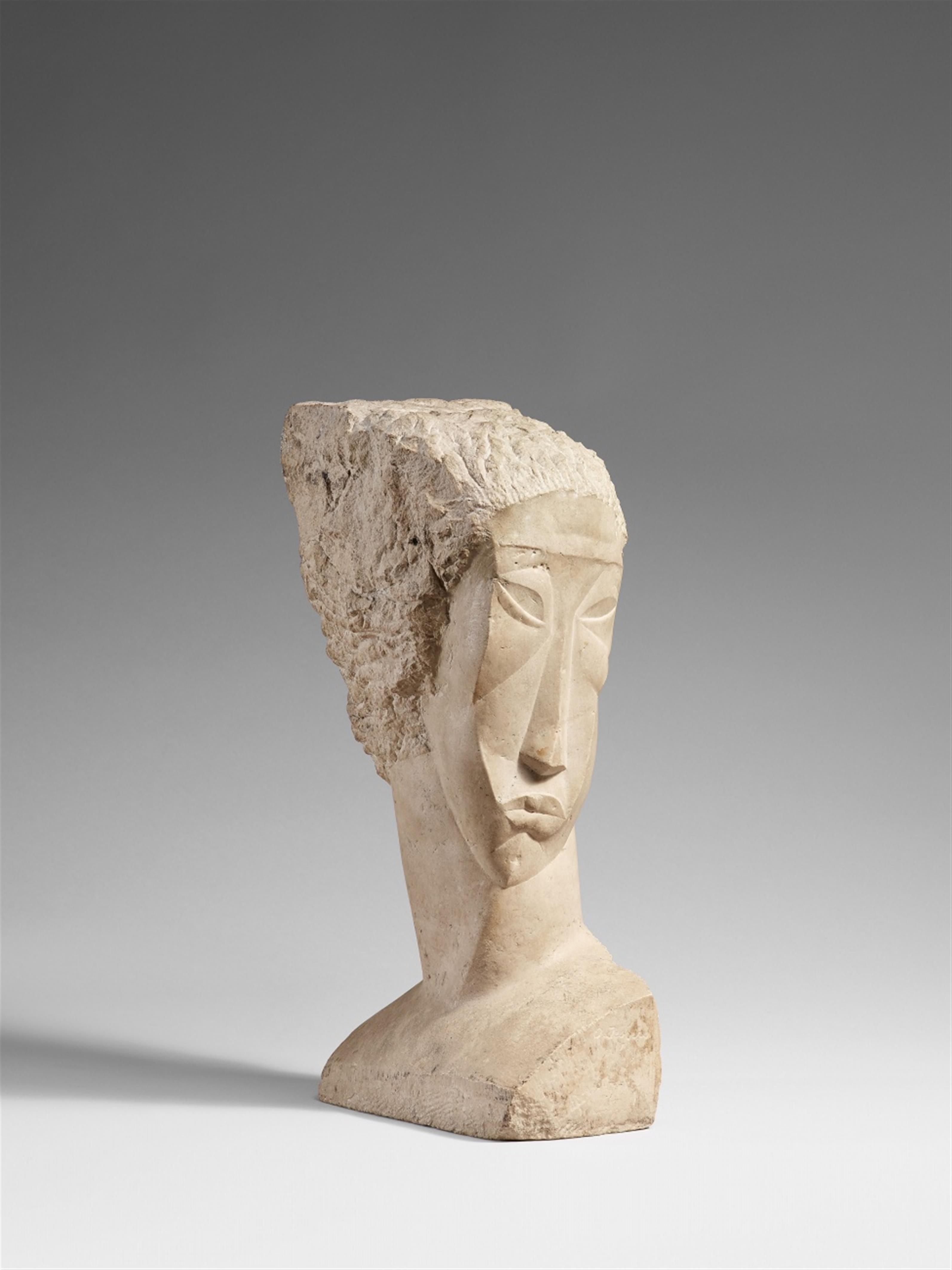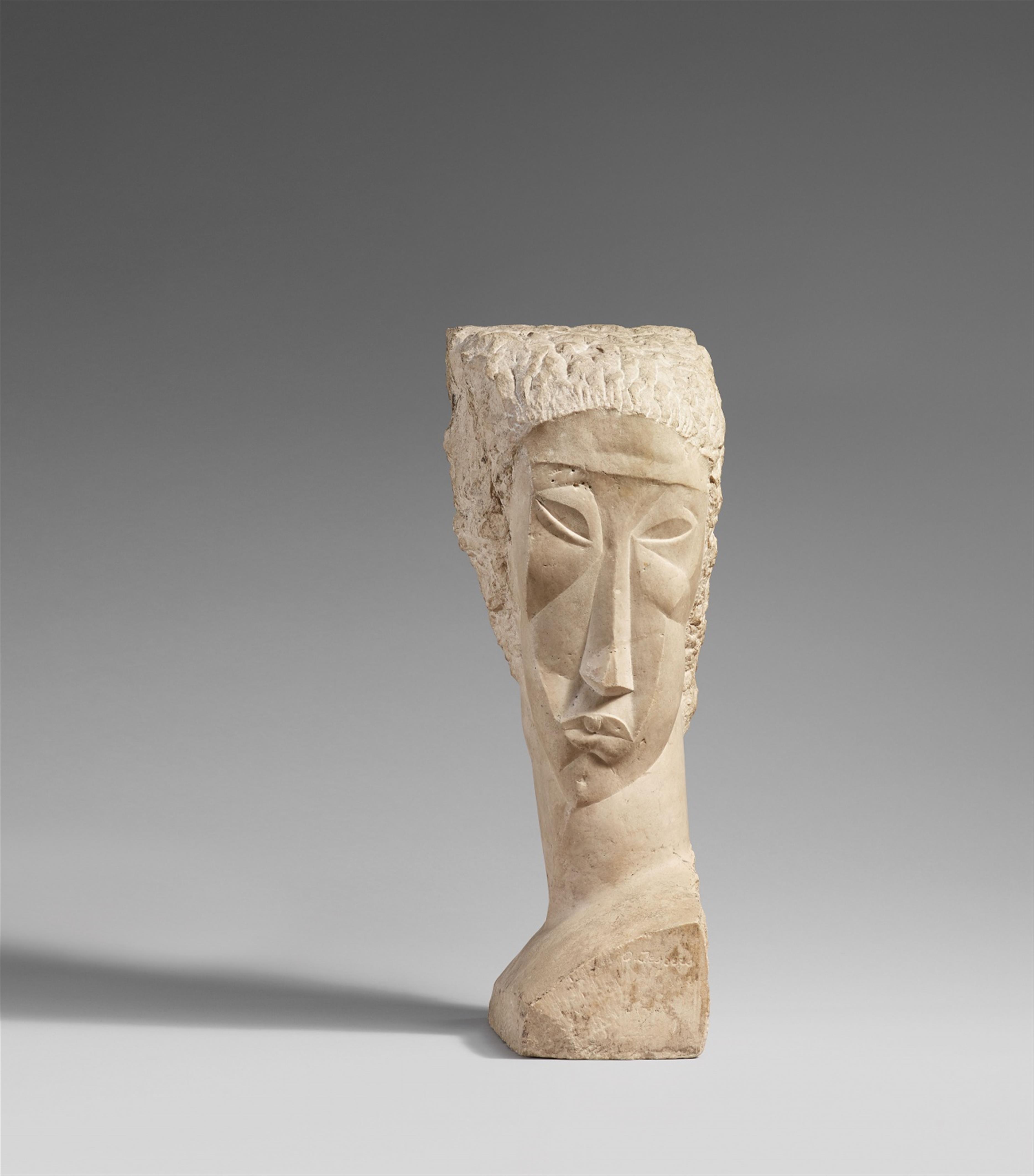Oscar Marie Frans Jespers
Vrouwehoofd (Frauenkopf)
1930
White marble Height 51.5 cm Signed 'O. Jespers' on the right side of the bust. - Underneath with some old exhibition labels. Unique. - The surface with natural age-related patina.
Oskar Jespers was born into a family of sculptors; his father Emile Jespers was also a sculptor. At that time, around the turn of the century, Constantine Meunier and George Minne represented modern sculpture in Belgium. While Jespers was a student, he also became aware of Auguste Rodin and shared the sculptural approach of his contemporaries Constantin Brancusi, Amadeo Modigliani, Alexander Archipenko, Jacques Lipchitz, Ossip Zadkine and Pablo Picasso. Although his engagement with French Cubism did not begin until during the First World War and he did not seriously occupy himself with the expressive substance of French sculpture until the 1920s, Jespers nonetheless added greater depth to his own style - after years as a mature artist - in a form of Cubist expression which, relative to his contemporaries, only slightly abstracted or fragmented the representational figure, as had been typical in Paris since Rodin. Jespers allows his figures to keep their head and a firm link to the result of his inspiration. This is true of all the important works of the twenties and thirties. Various heads by Jespers, such as this marble bust from 1930, are related to Pablo Picasso's 1909 sculpture “Fernande”, which had already caused a sensation at that time, or they simultaneously display an affinity with Art Deco.
In 1927 Jespers was offered a teaching position in the field of decorative monumental sculpture at the Ter Kameren university of art in Brussels, which was directed by Henry van de Velde. Jespers understood how to link this challenge with his admiration for the static sculptural art of Egypt and found inspiration for his own work in the masks and female heads of the Luba (Congo), among other sources. The artist usually depicted the heads frontally or, as is the case here, he turned them to form a profile like those typical of Egyptian hieroglyphs. The heads' hairstyles additionally recall the wigs of members of the Egyptian court. The decorative treatment of the surface and the reserved stylisation of the coiffure, for example, are also characteristic of Jespers's work.
This striking female head in white marble was created in 1930 and is one of the sculptor's central works. The varying states of completion, for example, the “non-finito” in areas on the reverse side or in the hair, are astonishing. Jespers has used a classical sculptural stylistic device to bring out the fine, exotic-looking physiognomy of the face. In 1934 this marble was exhibited with other recent Expressionist works in stone at “Kunst van Heden” in Antwerp and was a great success. Last but not least, this female head was used to decorate the cover of the sculptor's catalogue raisonné, emphasising the importance this work also holds in the posthumous literature on Jespers. Alfred H. Barr, the founding director of the Museum of Modern Art and a Picasso expert, provided a contemporary acknowledgement of Jespers. In 1938 he purchased the artist's work “De bekoring van Sint Antonius” (The temptation of St Anthony), of 1934, thus recognizing the importance of the Belgian sculptor alongside the Parisian avant-garde sculptors working at the same time.
Catalogue Raisonné
Boyens 129 (with colour illus. on title cover)
Provenance
From the artist's estate, Collection P. Jespers, Tervuren; Galerie Patrick Derom, Brussels; Private collection, North Rhine-Westphalia
Literature
José Boyens, Een eigenzinnig kubisme, 1924-1930, De koppen, in: Oscar Jespers. Zijn beeldhouwwerk met een overzicht van de tekeningen, Antwerp 1982, cf. p.123 ff., especially p.135 with illus. p. 356 and colour illus. on title cover
Exhibitions
Antwerp 1931 (Feestzaal Meir), Kunst van Heden, cat. no. 213; Antwerp 1934 (Festzaal Meir), Kunst van Heden, Salon 1934, cat. no. 258; Luxembourg 1959 (Musée de l'État), Hippolyte Daeye- Oscar Jespers. Deux expressionnistes belges, cat. no. 44; Venice 1960 (XXX. Biennale internazionale d'arte), cat. no. 74, Belgian Pavillon cat. no. 16; Mons 1966 (Musée des Beaux-Arts), Oscar Jespers, cat. no.13; Elsene 1966 (Museum), Oscar Jespers, cat. no. 29 with illus.; Maastricht/Breda/Knokke-Heist 1975 (Bonnefantenmuseum/Cultureel Centrum De Beyerd/Cultureel Centrum), Beelden en tekeningen van Oscar Jespers en van beeldhouwers die bij hem gewerkt hebben, cat. no.20; Mechelen 1976 (Cultureel Centrum Burgemeester A. Spinoy), Kunst in Europa 1920-1960. Een confrontatie, cat. no. 189; Paris 1977 (Musée Rodin), Oscar Jespers, Sculptures, dessins, cat. no. 19 with illus.




